
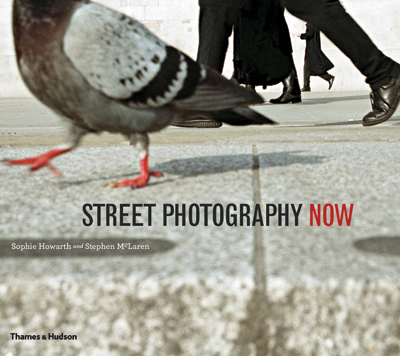
Trafalgar Square, London, 2007. © Matt Stuart. Images courtesy of Thames & Hudson

Street photography goes back at least to the 1930s, when Henri Cartier-Bresson roamed the streets of Paris with his lightweight Leica in hand. But it really came of age in the 1950s, when photographers like Garry Winogrand, Lee Friedlander, and Joel Meyerowitz made a point of spending all day on the streets, catching quirky, serendipitous moments of everyday life. The challenge, always, was to be in the right place at the right time, alert and perfectly positioned to capture what Cartier-Bresson called “the decisive moment” — when background, subject, and mood came together in surprising and revealing ways
In Street Photography Now (Thames & Hudson), authors Sophie Haworth and Stephen McLaren have put together a survey of some of the world’s best street photography at this particular moment. That’s no easy task, of course. The advent of sites like Facebook, Flickr, and Twitpic has made almost all of us into street photographers of one sort or another. To narrow down the task, Haworth and McLaren sought out “the strongest work by the most committed practitioners”, choosing forty-six photographers to represent the genre. Included are are some long-established names — such as Meyerowitz, who’s still going strong fifty years after his debut — but most of the photographers are up-and-coming, in their late thirties and early forties. In other words, they’re old enough to have developed a signature style, but young and energetic enough to pound the pavement every day.
(more…)
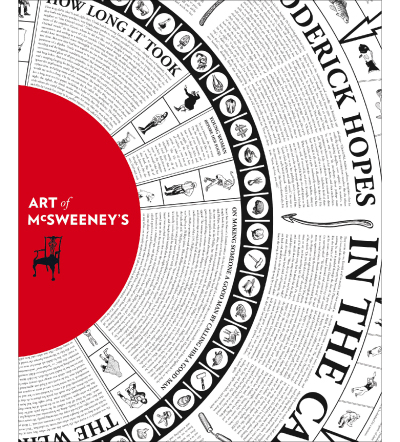
Photography courtesy of Chronicle Books

With this summer’s release of
Art of McSweeney’s, Dave Eggers and co. may have provided the most compelling reason yet to hold off on buying a Kindle. Though
Art of McSweeney’s is technically an anniversary tribute to the unfailingly original visuals in the pages and on the covers of all publications under the McSweeney’s umbrella —
The Believer magazine,
McSweeney’s Quarterly Concern, all four imprints of McSweeney’s Books — the über-illustrated tome is a typically large McSweeney’s undertaking, a tribute to the very existence and possibilities of print media.
“We spend a good deal of time editing books, and producing books of the highest quality we’re capable of, in the hopes that in doing so, we’ll keep people mindful of the pleasures of the book-as-object,” explains Eggers in the book’s early pages, alongside his dedication to “these physical books that purportedly have no future”.
True to their mission, the McSweeney’s team has created an object that can only be properly experienced in hard copy. From diagrams to illustrations to behind-the-scenes photos (Joyce Carroll Oates playing Sega stands out as a highlight)
Art of McSweeney’s reads like a 264-page love letter to all things printed and bound, complete with a muse board of old school book covers that would make Kanye West proud.
(more…)
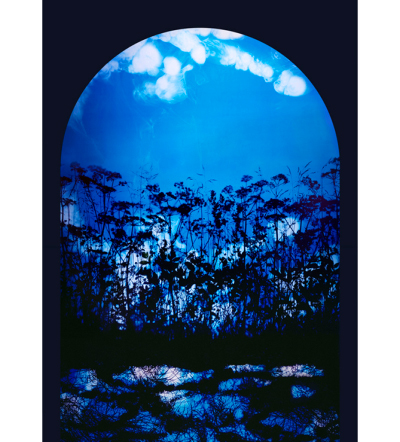
Arch 4 (Summer), Susan Derges Images courtesy of Victoria and Albert Museum (Click images to enlarge)

Made famous by the likes of Man Ray and Moholy-Nagy, camera-less experiments can be traced back to the genesis of photography. Beginning in the 1830s, artists continually broke new ground toying with light-blocking, shadow-casting and chemical manipulation, accidentally creating photogenic drawings, or photograms. Unlike virtually everything we know of today, camera-less images are truly unique and cannot be reproduced the same way twice. Often crafted to scale, the results are ephemeral, transient, and mysterious, offering a more intimate look at the object or figure being captured. Steeped in metaphor and reliant on the ‘unseen’, each image is an exploration — of life and death, time and timelessness, disappearing and emerging. The paradigm of normal perception is questioned as discoveries are made in the shadows.
This month, five leading contemporary artists of camera-less fame will be featured in
Shadow Catchers, a new exhibit opening at London’s
V&A. The exhibition includes an impressive array of enigmatic images that marry the effects of light, movement, science, and art. Eerie silhouettes, spectral forms and magical traces of smoke, air, and water leave the viewer in a perpetual state of suspended disbelief. Five short films and a beautiful hardback book published by Merrell Publishers accompany the exhibit. Together, Pierre Cordier (Belgium), Susan Derges (UK), Adam Fuss (UK/USA), Garry Fabian Miller (UK), and Floris Neusüss (Germany) have done more for the art form than any group of contemporary artists that came before them.
(more…)

assume vivid astro focus by Cay Sophie Rabinotwitz, courtesy of Rizzoli, 2010.

In today’s instamatic culture where attention spans are steadily decreasing and whoever shouts loudest wins, it seems creative minds have only two ways to go — you either embrace the cultural noise or retreat from it. Assume vivid astro focus, the growing, multi-striped art collective, seems to wholly embrace the speed-of-light changes with its collages and installations. The group’s chosen aesthetic method is sensory overload — an explosion of colors and sounds. The work itself is mostly collages and installations, the copy-and-paste, low-brow material that ranges from carnivals to gay porn. This just might be the logical end of postmodernism.
Avaf, as it is also known, became recognized in 2004 with its outrageous, cacophonous installations. The collective’s artists have done many since and their work has been exhibited in major museums in the US and abroad. The new, eponymous book (
Rizzoli, $60) documents the collective’s work in a gorgeous visual tome with 270 illustrations. The volume also includes an avaf-designed, a surprisingly understated (by avaf standards) poster, and a mask with 3-D glasses — just in case your brain does not explode from seeing their vibrant pastiches with the unassisted eye.
The text that opens the book is an engaging essay by Cay Sophie Rabinowitz, director of Art Basel. As with any loud, campy art, the natural question arises — are these guys serious? Is this a critique of contemporary culture or its indulgence? Rabinowitz offers no answer. I guess you will have to decide for yourself.
(more…)

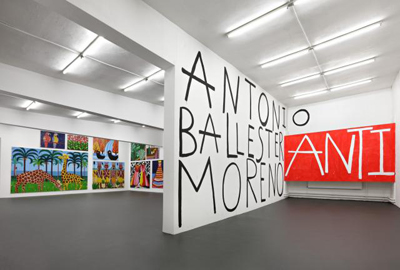
Installation View. Photography courtesy of Peres Projects.


While the writings of William Morris, a key figure in the 19th-century Arts & Crafts Movement, provided the jumping-off point for Spanish artist Antonio Ballester Moreno’s current show,
ANTI, at
Peres Projects in Berlin, Moreno’s works are anything but retrogressive. Moreno’s colorful, folk-art-inspired paintings focus on the keenly contemporary idea of a sustainable life, in response to the obvious damage and limitations of the industrialized world we live in. Nature, anti-capitalism, and “the innate potential of human beings” run throughout this show, counterbalanced by Moreno’s clear questioning of the Utopianism inherent in those ideas.
Moreno has also long focused on the truths and naivete of childhood, filtering his ideas through basic, impulsive strokes of paint as well as the bright colors we associate with children. But the simplicity of his figures belies a complex commentary on art history, our consumption of art and the place of art in our contemporary existence, in which the relationship between man and nature is harrowingly tenuous, if not entirely broken. As the gallery tells us: “His faux naïve style imparts a false sense of bucolicism, tempered by his particular brand of humor.” The second exhibition of Moreno’s at Peres Projects,
ANTI presents itself to us as a beautiful double-narrative that grapples with the ways in which we think about our place in nature.
ANTI will be on display until October 30 at Peres Projects, Berlin.
(more…)

Photography by Lyle Owerko

Do you remember? It was an unforgettable time. The kind that, in hindsight, you can say, “something really unique was happening then”. But the late 1970s was a time when people with very little, especially in New York City, were just making the best with what they had: each other, music, and a new type of portable sound system — the boombox.
In
Lyle Owerko’s new book
The Boombox Project, the New York-based photographer intended to turn subject into art, and photograph his personal collection of radios. But once he started hearing stories about his topic, the outcome shifted dramatically. In this book, you are invited to listen in on some of the most iconic MCs, musicians, and artists of that generation, recollecting about life on the streets and how the boombox grew to be so much more than just another radio. Filmmaker Spike Lee starts the book off with a foreword about Joe Radio, the first guy he ever saw listening to a portable radio on the corner of his Brooklyn block. From there, Owerko reveals stories from the likes of LL Cool J, Fab 5 Freddy, Kool Moe Dee, and Rosie Perez about their first encounters and experiences with the boombox. All their memories share a common thread: community. Today, we hear so much about sharing online, whether it’s music files or social networking. But the true pioneers of electronic sharing came from the boombox generation. It was a time of great creative growth.
(more…)
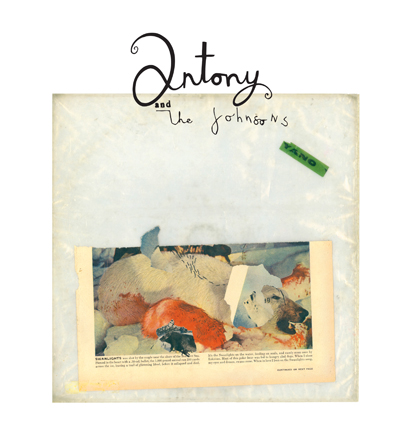
Images courtesy of Abram's Publishing

With much of the music shared online today, and the recording industry in crisis, artists increasingly turn to new means of distributing their work. Antony Hegarty, the transgender singer, whose ironically (or unfortunately, depending on one’s point of view) named band, the Johnsons, is no exception. For his new album,
Swanlights, Antony produced a book by the same title, (
Abrams Image, $35), which includes the CD.
Antony is a famously tender and sensitive artist who aches in our rough world. His self-declared creed is seeing the world from a feminine perspective (presumably, it’s the males who are solely responsible for messing everything up, because they are too aggressive). In the short essay accompanying the book, Antony calls out, “Circles of mothers, please usher in an era of profoundly feminine governance.” But what if one of those mothers is Margaret Thatcher?
Swanlights is reflective of Antony’s soft longing for escape from our male-induced filth, whether by dieing or by ushering in matriarchy. The music on the CD is gentle and full of feeling, especially the piano that is by turn forlorn and passionate. But it is Antony’s voice, powerful and yearning, that leaves the most lasting impression on the listener.
The art in the book is another matter. Its content is mostly made up of collages or old newspaper cutouts drawn over with haphazard pencil lines (Antony calls them “unconscious lines or spirit lines”).
(more…)

Dignity, cover. Photography by Dana Gluckstein. Click for Slideshow

When Dana Gluckstein made her first trip to photograph indigenous Haitians in the 1980s, she didn’t know she was embarking on a three-decade-long journey. Led by instinct, Gluckstein — then a young photographer shooting for advertising campaigns and annual reports — simply wanted to do some work that felt more profound and personal. “I always knew I wanted to go deep, rather than stay on the surface,” she says. “I knew this was important work.”
In the twenty-five years since, Gluckstein has indeed gone deep. She’s traveled far, both in terms of air miles and insight into the human condition. Her quest to document indigenous peoples — many of whose cultures are threatened — has resulted in the stunning book Dignity (powerHouse Books, $39.95), published this month to coincide with the 50th anniversary of Amnesty International.
As Gluckstein is quick to point out, Dignity is more than just a beautiful coffee table book. It’s also a passionate call to action. While indigenous peoples comprise six percent of the global population and are among its most impoverished and oppressed inhabitants, they remain largely invisible and it’s easy to ignore their plight.
Shot in black and white on a vintage Hasselblad, Gluckstein’s images show us the beauty, strength, and vivacity of these “first peoples”. Often intimate, sometimes breathtaking, the photographs in Dignity have a classical feel and a rich, velvety softness. Gluckstein’s artistry is matched by her deep compassion for her subject matter — a compassion that has sustained her through a quarter century of work.
(more…)

All photography by Alfred Stieglitz. Courtesy of National Gallery of Art and Skira/Rizzoli.

The word “ambitious” barely covers the life and work of Alfred Stieglitz. He was a photographer, a gallery owner, a magazine editor, and probably the man most responsible for bringing photography to the art world. Along the way, he also found time to marry a young Georgia O’Keefe and seal her reputation as a painter.
As a photographer, Stieglitz experimented with many subjects, from New York street scenes to cloudscapes to sultry portraits of O’Keefe. Behind all of his images was the driving philosophy of “pictorialism”, a belief that photographs should look like paintings. His most celebrated image is The Steerage, a picture of poor immigrants on a steamship. Where another photographer might have focused on faces and gestures, Stieglitz makes it a Cubist-like study of form and light.
New York, and its teeming street life, was a subject Stieglitz returned to throughout his career. In
Alfred Stieglitz New York, the city is shown over a period of five decades, but always filtered through Stieglitz’s unique personality. Beauty and desolation are given equal weight. As Georgia O’Keefe once said of her husband, it was as though “something hot, dark, and destructive was hitched to the highest, brightest star”.
(more…)

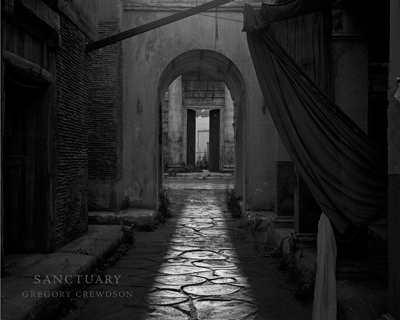
Sanctuary Cover, All photography by Gregory Crewdson. (Click images to enlarge)


Photographer
Gregory Crewdson is known for his staged tableux of everyday suburban scenes. He uses movie lighting and post-production effects to compose dramatically lit and colored images that, in their heightened realism, verge on the surreal. They’re physically accurate and emotionally unsettling, without easy sentimental meaning.
For his latest project, in an interesting reversal, Crewdson documented the exterior stage sets at
Cinecittà, the fabled movie studio in Rome. He worked in a more straightforward way, almost documentary-style, shooting in black and white and using natural light. These stately, evocative prints have been collected in a new book,
Sanctuary, and are on view at the
Gagosian Gallery on Madison Avenue in New York from September 23 through October 30.
What’s most striking about the scenes is their emptiness. There are no people here and no traces of them: no signage, no litter, no footprints or tire tracks. And yet the architecture of the sets invites occupation. There are plazas, walkways, and triumphal arched entryways. Where has everyone gone? As in the cityscapes of Giorgio DeChirico, the place seems to have been abandoned all at once, frozen in a historic moment by illness or catastrophe. Elements like half-open doors and stairs that lead nowhere have a dream-like resonance.
(more…)






 Facebook
Facebook Permalink
Permalink Digg
Digg Reddit
Reddit LinkedIn
LinkedIn StumbleUpon
StumbleUpon Tumblr
Tumblr













